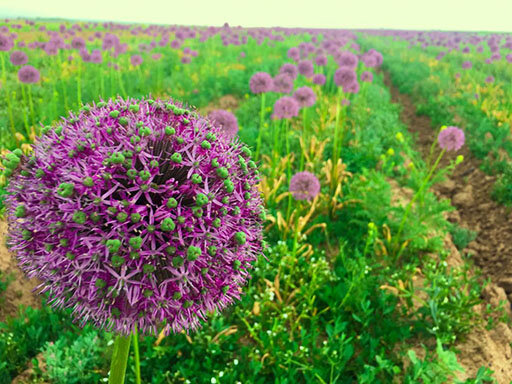Persian shallot: endemic plant tied to numerous health benefits

TEHRAN – Persian shallot (Allium hirtifolium) is native plant species of Iran and grows as a wild plant across the Zagros Mountains. The ancient plant is for long used for the treatment of rheumatic and inflammatory disorders.
Called ‘‘Mooseer’’ in Persian, the plant belongs to the Alliaceae family and is one of the important edible alliums in Iran.
In traditional medicine Persian shallot is recommended for the treatment of rheumatic and inflammatory disorders, gout, arthritis, diarrhea, stomach pain, psoriasis, and hemorrhoid.
Moreover, in modern medicine, Persian shallot has been reported to have a range of health benefits which include anticarcinogenic, hypoglycemic, hypolipidemic, antioxidant, antibiotic properties, kidney, and liver-protective effects. Here we review the medicinal properties of Persian shallot:
Persian shallot is a wild, perennial, herbaceous, and aromatic plant. It consists of a naked and erect scape with 80 to 120 cm height. The green leaves are linear and lanceolate with 20 to 30 cm in length and its flower’s color is red or violet. Bulbs of common shallot are pear-shaped, reddish-brown skinned, and clustered at the base of the plant and its clusters may contain as many as 15 bulbs.
Persian shallot production in Iran falls into three broad product segments; bulbs for fresh market, dehydrated Persian shallot for food processing, and green salad Persian shallots for fresh consumption.
Compared with common onions, shallots are a more concentrated source of protein, fiber, and micronutrients, including calcium, iron, magnesium, phosphorus, potassium, zinc, copper, folate, B vitamins, and vitamins A and C.
They are packed with powerful antioxidants and organosulfur compounds — all of which are responsible for many of their health benefits.
Hypoglycemic and antioxidant
The Persian shallot extract is a stronger hypoglycemic agent compared to garlic extract and it could be a useful supplemental remedy in diabetes.
Persian shallot preserves and protects the pancreas by its strong antioxidative capacity. So, it may be useful for preventing or delaying the development of diabetes and its complications. Also, Persian shallot had probably the ability to accelerate the hepatic glucose metabolism.
Probably some of these hypoglycemic and antioxidant properties of Persian shallot are related to its content of phenolic and sulfur compounds.
Kidney protective
Also, a significant elevation in serum creatinine, uric acid, and urea levels is indicative of impaired renal function in diabetic animals. It was shown Persian shallot extract improved renal function, which was evident from the lowered serum uric acid, and creatinine levels with Persian shallot extract.
The presence of polyphenols and flavonoids in Persian shallot extract might be responsible for the antioxidant nephroprotective activities and the reduction of serum uric acid and creatinine levels.
Hepatoprotective
A study revealed that using hydroalcoholic extract of Persian shallot could protect liver cells against oxidant effects of alloxan.
Furthermore, having antioxidant properties, these compounds are able to neutralize free radicals existing in the environment and prevent their destructive effects.
Antibiotic
Antimicrobial effects of three types of Persian shallot extract-fresh, dried and autoclaved extracts- were used and the results showed that fungal species were more sensitive to shallot extract than bacteria.
Therefore, this ancient plant is a potential source for the treatment of bacterial and fungal infections. Hence as an alternative, cheap and affordable eco-friendly plant extracts may possibly be used for the treatment.
The findings indicate that Persian shallot extract exerts antioxidant and antibacterial effects on vacuum-packaged rainbow trout during storage and increases its shelf life.
Anticancer
Persian shallot contains some useful biological secondary metabolites, which include allicin, S-allyl-cysteine, diallyldisulphide, and diallyltrisulphide. Allicin has been reported in the treatment of cancer.
The ability of Persian shallot to preferentially suppress the growth of neoplastic over non-neoplastic cells provides interesting possibilities for the development of new anticancer strategies in humans.
Other health benefits
Shallots are high in quercetin, a plant flavonoid that may help reduce and manage eye and nose symptoms related to seasonal allergies.
Quercetin may act as a natural antihistamine by preventing the release of histamine and lessening the severity of inflammatory and respiratory reactions like allergic asthma, bronchitis, and seasonal allergies.
Research indicates that the organosulfur compounds and antioxidants in shallots may benefit heart health and blood circulation in several ways, potentially lowering your risk of heart disease.
Shallots contain high amounts of thiosulfinates, a type of organosulfur compound that may prevent the formation of dangerous blood clots.
Some studies indicate that compounds in shallots may help prevent excess fat accumulation and lower total body fat percentage.
The use of Persian shallot is an additive to food or a drug without any side effects.
It could probably be stated that the extract of Persian shallot may provide a new therapeutic avenue against different diseases and their related complications.
FB/MG
Leave a Comment